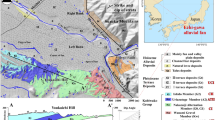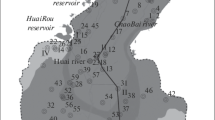Abstract
As a major and popular groundwater extraction structure, seepage wells are often used to transfer river water into aquifers for harvesting water resources. It can help ameliorate the imbalance between supply and demand, in particular, in areas of water scarcity. Large drawdowns due to pumping may cause the river to disconnect from the groundwater and form an unsaturated zone, which seriously affects the efficiency of seepage wells. However, most of the current models of extraction structures of non-tube wells account for only saturated flow and do not consider unsaturated conditions. To address this limitation, a saturated–unsaturated coupling model was developed using the exchange flow rate between the well pipe and the aquifer as the coupling point. Moreover, the model was evaluated with physical simulation test data. The statistical results indicated that the model could estimate the drawdown and pumping rate well with root-mean-square deviations of 0.0114 m and 0.0079 L s−1, respectively, for a river with strong leakage capacity; and 0.0129 m and 0.0099 L s−1, respectively, for a river with weak leakage capacity. The critical drawdown, where the river disconnects from the aquifer, as well as variations of the unsaturated zone, was also discussed. The present study provides important information for the design of seepage wells with reasonable drawdown, while being able to predict the potential water yield, and at the same time help protect the groundwater environment.











Similar content being viewed by others
Availability of data and materials
All data, models, or codes generated or used during the study are available from the corresponding author.
References
Ameli AA, Craig JR (2018) Semi-analytical 3D solution for assessing radial collector well pumping impacts on groundwater–surface water interaction. Hydrol Res. https://doi.org/10.2166/nh.2017.201
Brunner P, Cook PG, Simmons CT (2011) Disconnected surface water and groundwater: from theory to practice. Groundwater 49:460–467. https://doi.org/10.1111/j.1745-6584.2010.00752.x
Chang J, Ke X, Wang W, Sun TG (2019) Field test and numerical simulation on seepage well of Mazhen county. J Yangtze River Sci Res Inst 36:83–88
Chen X (2000) Measurement of streambed hydraulic conductivity and its anisotropy. Environ Geol 39:1317–1324. https://doi.org/10.1007/s002540000172
Chen C, Wan J, Zhan H (2003) Theoretical and experimental studies of coupled seepage-pipe flow to a horizontal well. J Hydrol 281:159–171. https://doi.org/10.1016/S0022-1694(03)00207-5
Chen YF, Yu H, Ma HZ, Li X, Yang Z (2020) Inverse modeling of saturated–unsaturated flow in site-scale fractured rocks using the continuum approach: a case study at Baihetan dam site, Southwest China. J Hydrol 584:124693. https://doi.org/10.1016/j.jhydrol.2020.124693
Cognac KE, Ronayne MJ (2020) Changes to inter-aquifer exchange resulting from long-term pumping: implications for bedrock groundwater recharge. Hydrogeol J 28:1–12. https://doi.org/10.1007/s10040-020-02141-x
Colebrook CF, White CM (1937) The reduction of carrying capacity of pipes with age. J ICE 7:99–118. https://doi.org/10.1680/ijoti.1937.14682
Diouf OC, Weihermüller L, Diedhiou M, Vereecken H, Sylla SN (2020) Modelling groundwater evapotranspiration in a shallow aquifer in a semi-arid environment. J Hydrol. https://doi.org/10.1016/j.jhydrol.2020.124967
Fu L (2012) Study on the rural drinking water safety guarantee system and engineering measures in arid and semi-arid area. Chang'an University
Glennon R (2007) Tales of French fries and bottled water: the environmental consequences of groundwater pumping. Environ Law 37:1
Hantush MS (1961) Aquifer tests on partially penetrating wells. Am Soc Civil Eng 87:171–195. https://doi.org/10.1029/JZ065i008p02467
Harbaugh AW (2005) MODFLOW-2005, the US Geological Survey modular groundwater model-the groundwater flow process. Center for Integrated Data Analytics Wisconsin Science Centers
Haverkamp R, Vauclin M, Touma J, Wierenga PJ, Vachaud G (1977) A comparison of numerical simulation models for one-dimensional infiltration. Soil Scisocamj 41:285. https://doi.org/10.2136/sssaj1977.03615995004100020024x
Lee E, Hyun Y, Lee KK (2010) Numerical modeling of groundwater flow into a radial collector well with horizontal arms. Geosci J 14:403–414. https://doi.org/10.1007/s12303-010-0037-x
Li P, Qian H (2013) Global curve-fitting for determining the hydrogeological parameters of leaky confined aquifers by transient flow pumping test. Arab J Geosci 6(8):2745–2753. https://doi.org/10.1007/s12517-012-0567-9
Li W, Wang L, Li Y (2011) Measurement of soil moisture characteristic curves of sandy medium by sandy funnel method. IEEE. https://doi.org/10.1109/ISWREP.2011.5893622
Li P, Wu J, Qian H (2014) Hydrogeochemistry and quality assessment of shallow groundwater in the southern part of the yellow river alluvial plain (Zhongwei Section), Northwest China. Earth Sci Res J 18:27–38. https://doi.org/10.15446/esrj.v18n1.34048
Maroney CL, Rehmann CR (2017) Stream depletion rate for a radial collector well in an unconfined aquifer near a fully penetrating river. J Hydrol 547:732–741. https://doi.org/10.1016/j.jhydrol.2017.02.010
Millington RJ, Quirk JP (1961) Permeability of porous solids. Trans Faraday Soc 5:1200–1207. https://doi.org/10.1039/tf9615701200
Mualem Y (1976) A new model for predicting the hydraulic conductivity of unsaturated porous media. Water Resour Res 12:513–522. https://doi.org/10.1029/WR012i003p00513
Munson BR, Young DF, Okiishi TH (2002) Fundamentals of Fluid Mechanics
Neumen SP (1973) Saturated–unsaturated seepage by finite elements. Proc Asce 12:1
Park E, Zhan H (2003) Hydraulics of horizontal wells in fractured shallow aquifer systems. J Hydrol 281:147–158. https://doi.org/10.1016/S0022-1694(03)00206-3
Qiao XY, Wang WK, Duan L, Wang YL, Xiao P (2020) Regional groundwater cycle patterns and renewal capacity assessment at the south edge of the Junggar Basin China. Environ Earth Sci. https://doi.org/10.1007/s12665-020-09045-9
Richards LA (1931) Capillary conduction through porous mediums. J Appl Phys. https://doi.org/10.1063/1.1745010
Shoemaker WB, Kuniansky EL, Birk S, Bauer S, Swain ED (2008) Documentation of a conduit flow process (CFP) for MODFLOW-2005. Techniques & methods
Simunek J, Sejna M, Genuchten M (1998) The HYDRUS-2D Software Package for Simulating Water Flow and Solute Transport in Two Dimensional Variably Saturated Media, Version 2.0
Sun K (2015) Numerical study identifying the factors causing the significant underestimation of the specific discharge estimated using the modified integral pumping test method in a laboratory experiment. J Contam Hydrol 180:1–11. https://doi.org/10.1016/j.jconhyd.2015.07.001
Sun Q (2017) Field test study of seepage well in Mazhen. Chang'an University
Thoms R, Johnson R, Healy R (2006) User's Guide to the Variably Saturated Flow (VSF) Process to MODFLOW. Usgs Usgeological Survey
Twarakavi N, Imnek J, Seo S (2008) Evaluating interactions between groundwater and vadose zone using the HYDRUS-based flow package for MODFLOW. Vadose Zone J. https://doi.org/10.2136/vzj2009.0190
van Genuchten MT (1980) A closed-form equation for predicting the hydraulic conductivity of unsaturated soils. Soil Sci Soc Am J 44:892–898. https://doi.org/10.2136/sssaj1980.03615995004400050002x
Wang W, Zhang G (2008) Numerical simulation of groundwater flowing to horizontal seepage wells under a river. Hydrogeol J 16:199–199. https://doi.org/10.1007/s10040-007-0257-y
Wang W, Liu J, Chen L, Ning L, Xue L (2009) Determination on the reasonable drawdown of vertical well of a seepage well. J Earth Sci Environ. https://doi.org/10.3969/j.issn.1672-6561.2009.03.010
Wang W, Chen P, Zheng Q, Zheng X, Lu K (2013) A modified calculation model for groundwater flowing to horizontal seepage wells. J Earth Syst Sci 122:407–418. https://doi.org/10.1007/s12040-013-0283-1
Wang W, Lv J, Xu D, Li L, Jia Y (2017) Migration of induced-infiltration stream water into nearby aquifer due to a transverse horizontal well in loess areas. Environ Earth Sci 76:572. https://doi.org/10.1007/s12665-017-6904-2
Wang D, Wu J, Wang Y, Ji Y (2020) Finding high-quality groundwater resources to reduce the hydatidosis incidence in the Shiqu County of Sichuan Province, China: analysis, assessment, and management. Exposure Health 12(2):307–322. https://doi.org/10.1007/s12403-019-00314-y
Wang J (2013) Study on the high efficient development manner of groundwater in yellow river valley with thin aqufier Chang'an University
White I, Broadbridge P (1988) Constant rate rainfall infiltration: a versatile nonlinear model: 2. Appl Solut Water Resour Res 24:155–162. https://doi.org/10.1029/WR024i001p00155
Wu Z, Deng C, Si J, Kan Z, Yue M (2019) Study on optimization of new type of seepage well structure in Sponge City. Iop Conference 472:012074. https://doi.org/10.1088/1757-899X/472/1/012074
Xie Y, Cook PG, Brunner P, Irvine DJ, Simmons CT (2015) When can inverted water tables occur beneath streams? Ground Water. https://doi.org/10.1111/gwat.12109
Zhan H, Wang L, V., Park, E. (2001) On the horizontal-well pumping tests in anisotropic confined aquifers. J Hydrol. https://doi.org/10.1016/S0022-1694(01)00453-X
Zhang W, Huang G, Zhan H (2008) An analytical solution for non-Darcian flow in a confined aquifer using the power law function. Adv Water Resour 364:99–106. https://doi.org/10.1016/j.jhydrol.2008.10.009
Zheng C, Imnek J, Lu Y, Liu X, Li H (2020) Monitoring and modeling the coupled movement of water, vapor, and energy in arid areas. J Hydrol 590:125528. https://doi.org/10.1016/j.jhydrol.2020.125528
Zhu Y, Shi L, Lin L, Yang J, Ye M (2012) A fully coupled numerical modeling for regional unsaturated–saturated water flow. J Hydrol 19(475):188–203
Acknowledgements
We acknowledge the 908 Team of Hydrogeology and Engineering Geology, and the Research Institute of Exploration and Development, PetroChina Changqing Oilfield Branch Company for offering financial support. We acknowledge the Ecoenvironmental Protection Forum of the Yellow River Basin for giving us this opportunity to submit and publish. We are grateful to Professor Peiyue Li for editing and reviewing the paper. We are sincerely grateful to all reviewers and the editors for their meaningful comments, which have helped us to improve the quality of the original manuscript.
Funding
This study was sponsored by the Shaanxi Geological and Mining Corporation (Grant No. KY201503). This research was also funded by the Fundamental Research Funds for the Central Universities, CHD (Grant No. 300102290401).
Author information
Authors and Affiliations
Contributions
XK designed the experiment, established the model, and wrote the manuscript. Wei Wang guided the experiment, established the mathematical model, and edited the manuscript. XX analyzed the data and draw the figures. JL checked the manuscript for error and submitted the manuscript. HH collected all the experiment data. All authors participated in and finished the experiment, gave comments, and contributed to the final version of the manuscript.
Corresponding author
Ethics declarations
Conflict of interests
The authors declare that they have no known competing financial interests or personal relationships that could have appeared to influence the work reported in this paper. The authors declare that they have no conflict of interest.
Additional information
Publisher's Note
Springer Nature remains neutral with regard to jurisdictional claims in published maps and institutional affiliations.
Rights and permissions
About this article
Cite this article
Ke, X., Wang, W., Xu, X. et al. A saturated–unsaturated coupling model for groundwater flowing into seepage wells: a modeling study for groundwater development in river basins. Environ Earth Sci 80, 711 (2021). https://doi.org/10.1007/s12665-021-10035-8
Received:
Accepted:
Published:
DOI: https://doi.org/10.1007/s12665-021-10035-8




